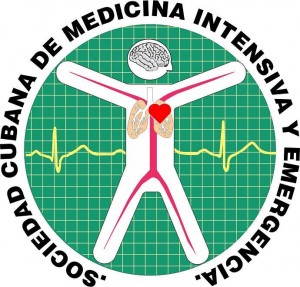Cateterización de la vena axilar en tiempo real con vista oblicua: influencia de la abducción del brazo
Palabras clave:
vena axilar, canalización de la vena axilar guiada por ultrasonido en tiempo real, vena central, acceso infraclavicular, cuidados intensivosResumen
Introducción: La vena axilar es un vaso accesible con guía ecográfica.
Objetivo: Evaluar la influencia de la abducción del brazo durante la cateterización ecoguiada en tiempo real con eje oblicuo de la vena axilar.
Métodos: Se realizó un estudio de descriptivo, prospectivo y aleatorizado en el Hospital Hermanos Ameijeiras, con 41 pacientes. Se efectuó la asignación aleatoria a los grupos de intervención (con/sin abducción del brazo ipsilateral).
Resultados: La cateterización fue exitosa en el 100 % de los casos con tiempos inferiores a 15 s. No se demostró un incremento de las complicaciones en relación con la obesidad, situaciones de riesgo, tamaño del vaso o el tiempo de realización. Se demostró una correlación lineal entre las complicaciones y el número de intentos realizados, así como el incremento de la distancia piel-vaso. Existió asociación entre la distancia piel-vaso y el tiempo de realización. La abducción o no del brazo no influyó en la presencia de localizaciones no erráticas.
Conclusiones: La cateterización venosa central ecoguiada de la vena axilar con vista oblicua constituye un sitio de acceso con altas tasas de efectividad y bajo porcentaje de complicaciones. La abducción del brazo si bien incrementa la visualización del vaso no disminuyó las posiciones erráticas de la cateterización venosa central.
Descargas
Citas
Referencias
1 Gawda R, Czarnik T, Łysenko L. Infraclavicular access to the axillary vein - new possibilities for the catheterization of the central veins in the intensive care unit. Anaesthesiol Intensive Ther. 2016;48(5):360-366. doi: 10.5603/AIT.a2016.0055. Epub 2016 Nov 21. PMID: 27869288.
2.Nickalls RW. A new percutaneous infraclavicular approach to the axillary vein. Anaesthesia. 1987 Feb;42(2):151-4. doi: 10.1111/j.1365-2044. 1987.tb02988.x. PMID: 3826589.
3.Taylor BL, Yellowlees I. Central venous cannulation using the infraclavicular axillary vein. Anesthesiology. 1990 Jan;72(1):55-8. doi: 10.1097/00000542-199001000-00011. PMID: 2297133.
4.Bodenham A, Lamperti M. Ultrasound guided infraclavicular axillary vein cannulation, coming of age. Br J Anaesth. 2016 Mar;116(3):325-7. doi: 10.1093/bja/aev445. Epub 2016 Jan 20. PMID: 26792639.
5.Czarnik T, Gawda R, Nowotarski J. Real-time ultrasound-guided infraclavicular axillary vein cannulation: A prospective study in mechanically ventilated critically ill patients. J Crit Care. 2016 Jun; 33:32-7. doi: 10.1016/j.jcrc.2016.02.021. Epub 2016 Mar 2. PMID: 26993368.
6.Tagliari AP, Kochi AN, Mastella B, Saadi RP, di Leoni Ferrari A, Saadi EK, Polanczyk CA. Axillary vein puncture guided by ultrasound vs cephalic vein dissection in pacemaker and defibrillator implant: A multicenter randomized clinical trial. Heart Rhythm. 2020 Sep;17(9):1554-1560. doi: 10.1016/j.hrthm.2020.04.030. Epub 2020 Apr 29. PMID: 32360827.
7.Rewari V, Ramachandran R, Pande A. Compression with the ultrasound probe to prevent malposition of central venous catheter in the ipsilateral internal jugular vein during axillary vein cannulation. J Clin Ultrasound. 2019 Feb;47(2):95-96. doi: 10.1002/jcu.22666. Epub 2018 Nov 25. PMID: 30474132.
8.Ravindran C, Thiyagarajan S, Velraj J, Murugesan R. Arm position and collapsibility of infraclavicular axillary vein during voluntary breathing: An ultrasound-guided observational study. J Vasc Access. 2020 Jan;21(1):39-44. doi: 10.1177/1129729819848918. Epub 2019 Jun 5. PMID: 31165669.
9.Pittiruti M, Biasucci DG, La Greca A, Pizza A, Scoppettuolo G. How to make the axillary vein larger? Effect of 90° abduction of the arm to facilitate ultrasound-guided axillary vein puncture. J Crit Care. 2016 Jun; 33:38-41. doi: 10.1016/j.jcrc.2015.12.018. Epub 2015 Dec 29. PMID: 26848024.
10.Brescia F, Biasucci DG, Fabiani F, Favarato M, Costa F, Longo F, Martuscelli M, Vitiello M, Pittiruti M. A novel ultrasound-guided approach to the axillary vein: Oblique-axis view combined with in-plane puncture. J Vasc Access. 2019 Nov;20(6):763-768. doi: 10.1177/1129729819826034. Epub 2019 Jan 31. PMID: 30704348.
11.Ahn JH, Kim IS, Shin KM, Kang SS, Hong SJ, Park JH, Kim HJ, Lee SH, Kim DY, Jung JH. Influence of arm position on catheter placement during real-time ultrasound-guided right infraclavicular proximal axillary venous catheterization. Br J Anaesth. 2016 Mar;116(3):363-9. doi: 10.1093/bja/aev345. Epub 2015 Oct 20. PMID: 26487153.
12.Yao M, Xiong W, Xu L, Ge F. A modified approach for ultrasound-guided axillary venipuncture in the infraclavicular area: A retrospective observational study. J Vasc Access. 2019 Nov;20(6):630-635. doi: 10.1177/1129729819838135. Epub 2019 Mar 28. PMID: 30919718.
13.Chandler JK, Apte N, Ranka S, Mohammed M, Noheria A, Emert M, Pimentel R, Dendi R, Reddy M, Sheldon SH. Ultrasound guided axillary vein access: An alternative approach to venous access for cardiac device implantation. J Cardiovasc Electrophysiol. 2021 Feb;32(2):458-465. doi: 10.1111/jce.14846. Epub 2021 Jan 2. PMID: 33337570.
14.De Sensi F, Addonisio L, Baratta P, Breschi M, Cresti A, Miracapillo G, Limbruno U. Body mass index is related to unsuccessful puncture attempts and failure to axillary vein cannulation during ultrasound-guided cardiac electronic device implantation. J Interv Card Electrophysiol. 2021 Aug;61(2):253-259. doi: 10.1007/s10840-020-00800-3. Epub 2020 Jun 23. PMID: 32572722.
15.Kang M, Ryu HG, Son IS, Bahk JH. Influence of shoulder position on central venous catheter tip location during infraclavicular subclavian approach. Br J Anaesth. 2011 Mar;106(3):344-7. doi: 10.1093/bja/aeq340. Epub 2010 Dec 7. PMID: 21138902.
16.Czarnik T, Gawda R, Nowotarski J. Real-time, ultrasound-guided infraclavicular axillary vein cannulation for renal replacement therapy in the critical care unit—A prospective intervention study. J Crit Care. 2015 Jun;30(3):624-8. doi: 10.1016/j.jcrc.2015.01.002. Epub 2015 Jan 8. PMID: 25697988.
17.Maddali MM, Arora NR, Chatterjee N. Ultrasound Guided Out-of-Plane Versus In-Plane Transpectoral Left Axillary Vein Cannulation. J Cardiothorac Vasc Anesth. 2017 Oct;31(5):1707-1712. doi: 10.1053/j.jvca.2017.02.011. Epub 2017 Feb 15. PMID: 28416391.
18.Sommerkamp SK, Romaniuk VM, Witting MD, Ford DR, Allison MG, Euerle BD. A comparison of longitudinal and transverse approaches to ultrasound-guided axillary vein cannulation. Am J Emerg Med. 2013 Mar;31(3):478-81. doi: 10.1016/j.ajem.2012.09.015. Epub 2012 Nov 22. PMID: 23177356.
19.He YZ, Zhong M, Wu W, Song JQ, Zhu DM. A comparison of longitudinal and transverse approaches to ultrasound-guided axillary vein cannulation by experienced operators. J Thorac Dis. 2017 Apr;9(4):1133-1139. doi: 10.21037/jtd.2017.03.137. PMID: 28523170; PMCID: PMC5418287.
20.Tufegdzic B, Khozenko A, Lee St John T, Spencer TR, Lamperti M. Dynamic variation of the axillary veins due to intrathoracic pressure changes: A prospective sonographic study. J Vasc Access. 2020 Jan;21(1):66-72. doi: 10.1177/1129729819852204. Epub 2019 Jun 16. PMID: 31204560.
21.Farina A, Coppola G, Bassanelli G, Bianchi A, Lenatti L, Ferri LA, Liccardo B, Spinelli E, Savonitto S, Mauri T. Ultrasound-guided central venous catheter placement through the axillary vein in cardiac critical care patients: safety and feasibility of a novel technique in a prospective observational study. Minerva Anestesiol. 2020 Feb;86(2):157-164. doi: 10.23736/S0375-9393.19.13670-X. Epub 2019 Jul 4. PMID: 31274266.
22.Su Y, Hou JY, Ma GG, Hao GW, Luo JC, Yu SJ, Liu K, Zheng JL, Xue Y, Luo Z, Tu GW. Comparison of the proximal and distal approaches for axillary vein catheterization under ultrasound guidance (PANDA) in cardiac surgery patients susceptible to bleeding: a randomized controlled trial. Ann Intensive Care. 2020 Jul 8;10(1):90. doi: 10.1186/s13613-020-00703-6. PMID: 32643012; PMCID: PMC7343682.






